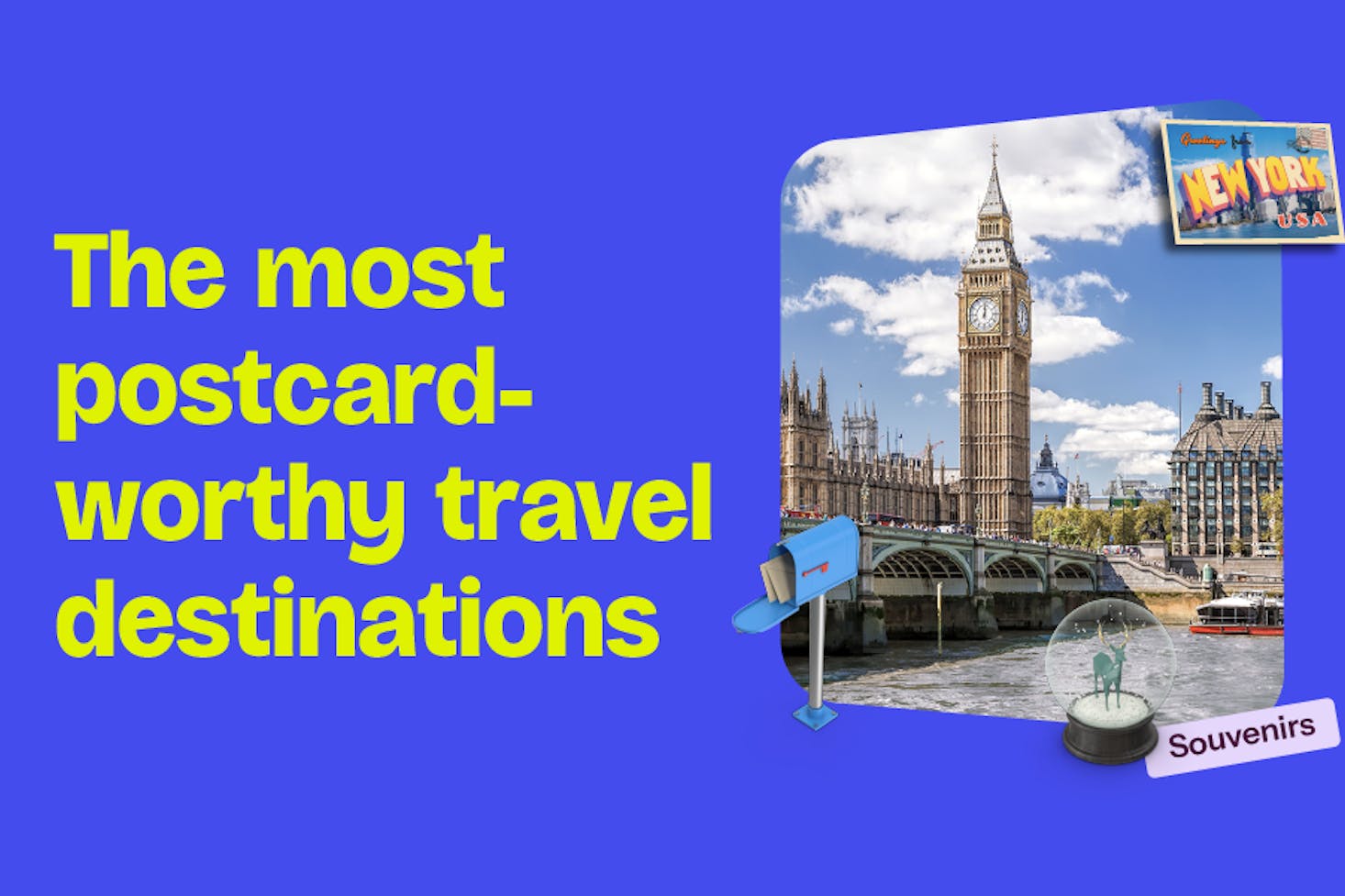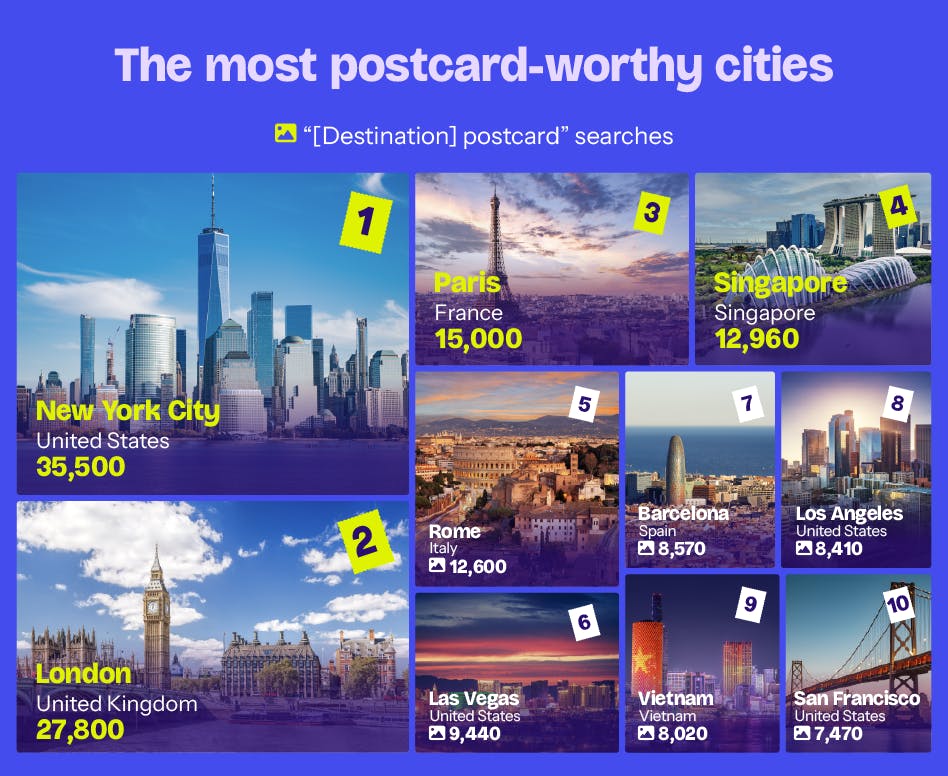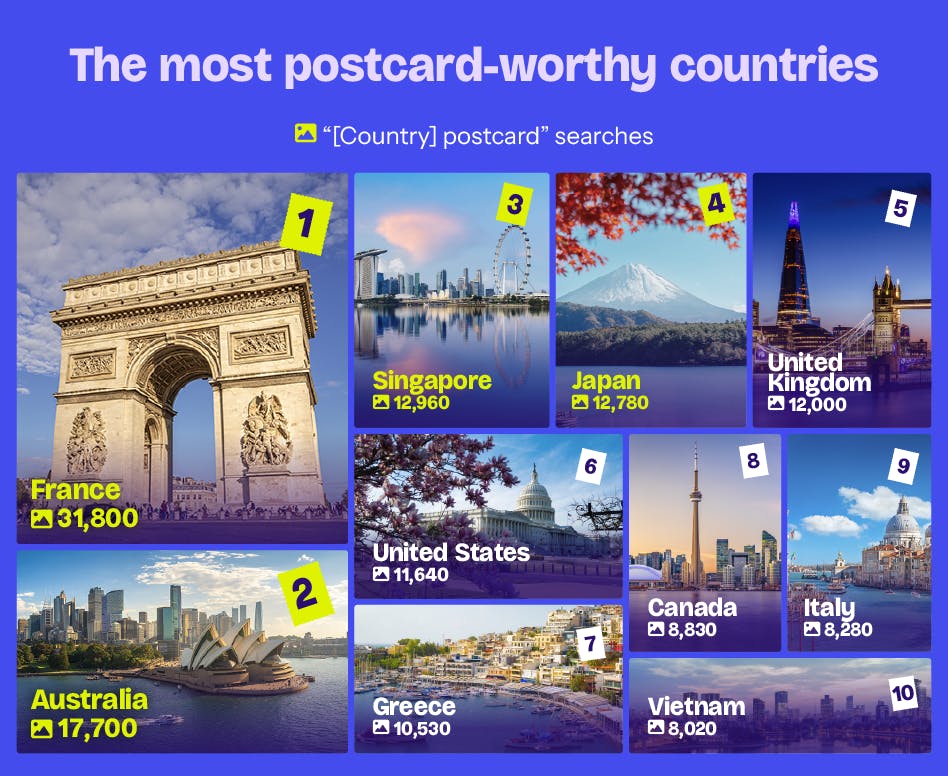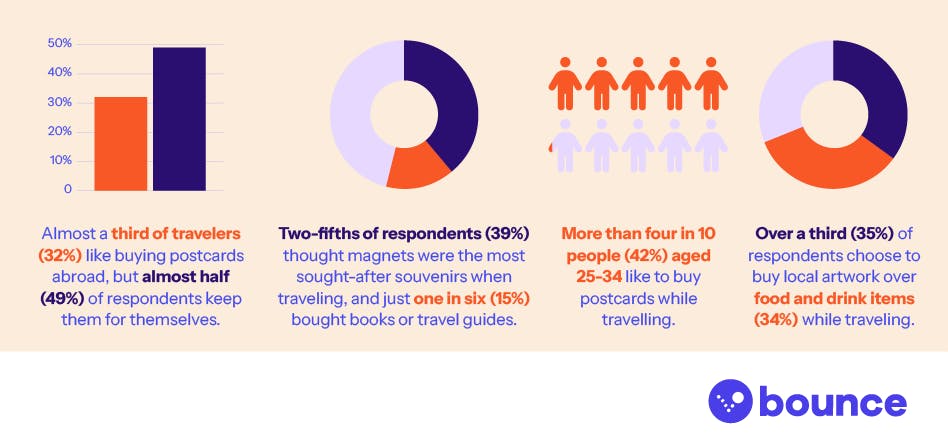The Most Postcard-worthy Travel Destinations

Despite the world being dominated by instant updates and social media, the humble postcard still holds a special place in travelers' hearts.
In this research, we’ve highlighted postcard-worthy destinations worldwide, using insights from searches and survey data to explore how the postcard industry is evolving in 2025.
We’ll feature expert guidance on why living in the moment is better than viewing the world through a lens, and our survey of 2,000 travelers will uncover whether tourists buy postcards to send or keep as souvenirs.
With the help of luggage storage network Bounce.com, travelers can explore these destinations unburdened, collecting keepsakes and embracing real experiences.
The most postcard-worthy countries
Get the app to unlock rewards

Book with the app and earn 10% back in Bounce credits. Every booking unlocks more credits for your next trip.
Scan to download


1. France
31,800 “postcard” searches
France tops the list for the most in-demand postcard countries, with 31,800 searches. This popularity reflects France’s widespread appeal as a travel destination, offering iconic sights like the Eiffel Tower, the Louvre Museum, and the picturesque streets of Paris, along with its beautiful countryside, historic cities, and stunning coastlines. The country’s rich culture, fine cuisine, and art captivate the hearts of people around the world, making it the top choice for those looking to send a piece of its charm through postcards.
2. Australia
17,700 “postcard” searches
Australia ranks second among the most in-demand postcard countries, with 17,700 searches for “Australia postcards.” Australia offers travelers iconic sights that are perfect for capturing in a postcard, such as the natural wonder of the Great Barrier Reef and the stunning coastlines of Bondi Beach. Famous landmarks like the Sydney Opera House, Uluru, and the Great Ocean Road are frequently featured in postcards, allowing visitors to share the country’s unique charm.
3. Singapore
12,960 “postcard” searches
Singapore holds the third spot for the most in-demand postcard searches, with 12,960 searches. Known for its impressive skyline and iconic monuments, Singapore’s unique blend of cityscapes and nature makes it a favorite among travelers. Its rich cultural diversity and attractions like Chinatown, Little India, and the vibrant hawker food scene, offer countless postcard-worthy moments.
The most postcard-worthy cities

1. New York City
35,500 ‘postcard’ searches
New York City stands out as the top destination for postcard searches, with 35,500 searches, highlighting the city's appeal as a must-see location for travelers around the globe.
Whether it's the iconic skyline, the Statue of Liberty, or the bustling streets of Times Square, people from all corners of the world are eager to capture the spirit of the Big Apple and share it with friends and family. In 2024, the United States Postal Service sent 2.4 billion presorted postcards via First-Class mail.
2. London
27,800 ‘postcard’ searches
London ranks second, with 27,800 ‘postcard’ searches. The iconic city of London is rich in history and culture, drawing millions of visitors every year. Its majestic Buckingham Palace and the historic Tower of London offer postcard-worthy scenes at every turn. The city’s charming blend of tradition and modernity, bustling markets, and world-renowned museums make it a prime destination for tourists looking to share the essence of British culture.
3. Paris
15,000 ‘postcard’ searches
Paris ranks third among the most popular postcard destinations, with 15,000 ‘postcard’ searches. Widely known as the City of Love, Paris is renowned for its romantic ambiance and artsy heritage, making it a top choice for travelers looking to capture its timeless beauty. With iconic landmarks such as the Eiffel Tower and Louvre Museum, to the charming streets of Montmartre, Paris offers endless picture-perfect moments.
How trends in the postcard industry are shifting in 2025
The tradition of sending postcards has declined in recent years, largely due to the rise of instant digital communication and increasing postage costs. Yet, despite this downward shift, more than 2.4 billion presorted postcards were still sent via first-class mail in the US in 2024.
Platforms like Postcrossing are helping keep the spirit of postcard-sending alive. As of January 2025, the platform has facilitated the exchange of over 80 million postcards, with around a million registered every two to three months. This global community values the personal connection a postcard holds, turning them into keepsakes rather than simple travel updates.
Many younger travelers are also rediscovering the charm of postcards, collecting them from each destination as tangible mementos. Rather than hiding them away, they’re framing their favorites or displaying them creatively at home. On social platforms like Instagram and Pinterest, postcard walls, photo maps, and travel-themed displays have become increasingly popular - mapping out adventures, pinning cards to regions, or curating themed walls that reflect personal travel styles. Mixed with ticket stubs, travel quotes, or miniature flags, these immersive memory boards do more than decorate a space - they tell a story that’s uniquely your own.
Postcard collecting - or deltiology - is also enjoying a quiet revival. With roots in the 19th century and followers across the globe (even Queen Victoria is rumored to have had a collection), it remains a much-loved hobby for fans of travel, history, and art. Vintage postcards, in particular, often carry historical or artistic value, making them prized possessions among collectors - even if most people don’t realize the hobby has a name.
How do travelers feel about postcards?
To determine how travelers feel about postcards, we surveyed 2,000 respondents, asking about their buying habits when buying postcards and souvenirs abroad.
According to our survey, almost a third of travelers like buying postcards abroad, but almost half of respondents keep them for themselves. Even with all the tech available today, saving postcards is still popular, as they can be pinned up or framed, allowing you to capture special moments from your travels.
Two-fifths of respondents buy magnets while traveling, and just one in six bought books or travel guides. As well as being practical and easy to pack, magnets allow travelers to feel an instant memory. ‘Fridge maps’ have become popular in recent years, with people adding magnets for every destination they’ve ventured to.
More than four in ten people aged 25-34 like to buy postcards while traveling. Almost three in ten people aged 55-64 agreed that postcards were not important to them and never bought them while traveling. These answers show some generational differences in consumer habits and values. Postcards have become trendy again, and many younger travelers appreciate vintage items and capturing the moment, as opposed to digital photos. Whereas older generations were once the main users of postcards, many have now embraced technology while traveling.
Over a third of respondents choose to buy local artwork over food and drink items while traveling. Many travelers may prefer local artwork as, unlike food, it doesn’t expire, serves as a permanent reminder of a trip, and can be displayed at home, making it a more lasting souvenir. Local artwork often reflects the history and traditions of a place, which adds a unique touch that other items may not capture.

Psychologist Dr. Carolyne Keenan comments on living in the moment while traveling, rather than experiencing everything through the lens of a camera:
“As a psychologist, I often explore why so many of us feel a strong urge to document our lives, especially while traveling. This behavior isn't just about collecting memories. It's deeply linked to how we make sense of our experiences and how we seek connection and validation in a social world.
“Psychologically, documenting moments- whether through photos, videos, or sharing online, taps into a number of core human needs. One of these is the need for identity and narrative. We are meaning-making creatures. Recording our travels can help us create a coherent story about who we are and the life we’re living. It’s a way of saying: This is what matters to me. This is part of my story.
“There’s also a strong social and relational drive. In a digital age, sharing our experiences can be a way of staying connected. It allows us to invite others into our world, to feel seen, and sometimes, to seek approval or affirmation. This isn’t inherently negative, being witnessed is a basic human need, but it can become problematic when the documenting becomes more important than the doing.
“From a psychological perspective, this compulsion can also be linked to 'FOMO' (the fear of missing out) and its quieter cousin, 'FOBO' (the fear of being ordinary). These anxieties can push us to seek exceptional experiences and ensure they are seen, recorded, and validated by others, particularly on social media.
“The downside is that in the act of trying to hold on to a moment, we can step out of it entirely. Our attention becomes split: part of us is present, but another part is already curating how the experience looks to others. Research in psychology suggests that when our attention is divided in this way, our emotional connection to the moment can be dulled, and we’re less likely to encode the memory deeply.
“To stay grounded while traveling and to support our wellbeing, it's helpful to slow down and check in with our senses. Pause and really absorb the moment: the warmth of the sun, the texture of the food, the smells, the rhythm of the local sounds. Even taking a short moment to breathe deeply before reaching for your phone can be enough to anchor you in the moment and be more intentional about how you want to experience it.
“Ultimately, some of the most powerful experiences we have aren’t the ones we post but the ones we fully feel- moments that we record in our bodies and memories.”
Cody Candee, CEO and Founder of Bounce.com, comments on why we should keep the tradition of sending postcards alive:
"Postcards offer more than just an image - they capture the essence of a moment in time, creating a real connection to the places we visit. In a world where we're constantly behind screens, the simple act of sending or collecting a postcard encourages us to slow down and truly live the experience. As we look towards 2025, the shift in the postcard industry reflects a deeper desire for authentic, meaningful memories over curated digital representations. The act of engaging with a destination in such a personal way allows us to embrace the moment, free from distractions, and to share that sense of presence with others."
Cody Candee also offers more ways to live in the moment while traveling:
1. Limit your screen time
“To make the most of their trip, travelers should try to limit their screen time. Take a few photos, then put your phone away. Posting on social media can wait, but real-life experience can’t.
2. Talk to locals
“Travelers should engage with locals, as the people you meet while traveling often leave a lasting impression on you. So ask them for recommendations on things to do or their favorite restaurants, directions, or practice talking in a different language.
3. Slow down
“It’s usually tempting to fill every moment on your travels with plans & activities; however, slowing down often allows you to embrace the unplanned moments. By planning your trip loosely, you can leave space for spontaneity, and some of the best memories come from unexpected moments.
- Travel light
“The less you carry, the freer you feel. Pack less than you think you need, and let Bounce luggage storage handle the rest. By letting go of the “perfect trip” ideology, you can expect a hands-free and in-the-moment experience, without having to worry about your belongings.
5. Savor meals
“Savoring food while traveling is an underrated part of the experience. Put your phone away and engage with your senses. Try unfamiliar things while in a new country. By trying new textures and spices, you’ll have core memories of the entire experience.
6. Journal
“Write down your experiences, so you can reflect on your trip so far and share with others. This could be after a particularly enjoyable meal or an unforgettable excursion. Journaling while traveling allows you to turn your trip into something meaningful and memorable. It has also proven to reduce feelings of overwhelm and make you feel more grounded.”
Methodology
Google Keyword Planner was used to find the number of “souvenir” and “postcard” searches in each travel destination and country between March 2024 and February 2023. This data is accurate as of 24/03/25.
We surveyed 2,000 people to gauge whether they purchase postcards to keep as souvenirs or send them to friends and family and to learn their buying habits when shopping abroad.
Sources
https://www.sequeldm.com/direct-mail-research/
https://about.usps.com/who/profile/history/postcard-volume-since-1926.htm
https://www.postalmuseum.org/collections/highlights/postcards/
https://www.shutterfly.com/ideas/how-to-create-a-travel-photo-book/
https://www.10adventures.com/collecting-memories-while-travelling/
https://hub.wtm.com/blog/social-media/what-the-millions-of-people-using-pinterest-for-travel-inspo-are-looking-for/
https://en.wikipedia.org/wiki/Deltiology
https://www.nextdayflyers.com/deltiology-for-beginners.html#:~:text=Deltiology%2C%20derived%20from%20the%20Greek,behind%20collecting%20money%20and%20stamps.
https://www.postcrossing.com/stats/postcards
Get the app to unlock rewards

Book with the app and earn 10% back in Bounce credits. Every booking unlocks more credits for your next trip.
Scan to download

